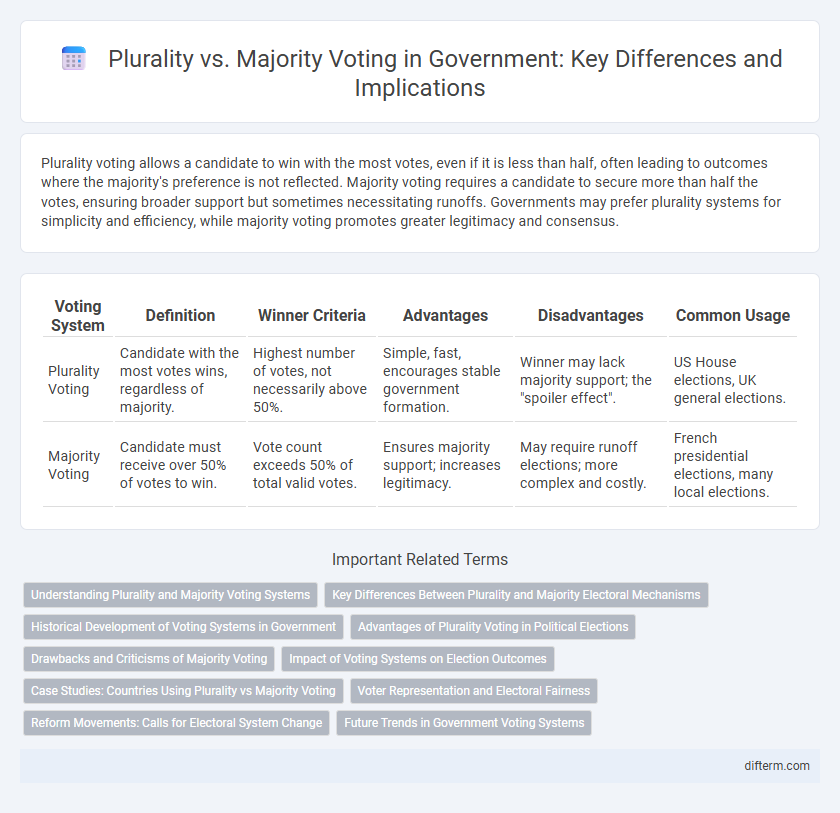Plurality voting allows a candidate to win with the most votes, even if it is less than half, often leading to outcomes where the majority's preference is not reflected. Majority voting requires a candidate to secure more than half the votes, ensuring broader support but sometimes necessitating runoffs. Governments may prefer plurality systems for simplicity and efficiency, while majority voting promotes greater legitimacy and consensus.
Table of Comparison
| Voting System | Definition | Winner Criteria | Advantages | Disadvantages | Common Usage |
|---|---|---|---|---|---|
| Plurality Voting | Candidate with the most votes wins, regardless of majority. | Highest number of votes, not necessarily above 50%. | Simple, fast, encourages stable government formation. | Winner may lack majority support; the "spoiler effect". | US House elections, UK general elections. |
| Majority Voting | Candidate must receive over 50% of votes to win. | Vote count exceeds 50% of total valid votes. | Ensures majority support; increases legitimacy. | May require runoff elections; more complex and costly. | French presidential elections, many local elections. |
Understanding Plurality and Majority Voting Systems
Plurality voting systems award victory to the candidate with the most votes, even if they do not achieve an absolute majority, often leading to winners with less than 50% support. Majority voting requires a candidate to receive more than half of the votes, promoting broader consensus but potentially necessitating runoff elections. Understanding these distinctions is crucial for analyzing electoral outcomes and democratic representation in government systems.
Key Differences Between Plurality and Majority Electoral Mechanisms
Plurality voting allows a candidate to win with the highest number of votes, even if it is less than 50%, whereas majority voting requires a candidate to secure more than 50% of the votes to win. In plurality systems, the winner may not represent the preference of the majority, which can lead to less consensus, while majority systems often involve runoffs or preferential voting to ensure broad support. The choice between these mechanisms affects election strategies, voter behavior, and overall democratic legitimacy.
Historical Development of Voting Systems in Government
The historical development of voting systems in government is marked by the evolution from plurality voting, where the candidate with the most votes wins, to the adoption of majority voting systems that require more than half the votes for a decisive outcome. Plurality voting, also known as first-past-the-post, dominated early democratic processes due to its simplicity and ease of implementation in emerging governments, influencing electoral structures in countries like the United Kingdom and the United States. The shift towards majority voting systems emerged to address issues of representation and legitimacy, leading to innovations such as runoff elections and preferential voting in various democracies worldwide.
Advantages of Plurality Voting in Political Elections
Plurality voting simplifies election processes by allowing the candidate with the most votes to win without requiring a majority, thus reducing the likelihood of extended runoffs and election delays. This system encourages straightforward voter decision-making and often leads to stable governments by favoring prominent candidates from major parties. Plurality voting also facilitates quicker results and cost-effective elections, benefiting administrative efficiency in political systems.
Drawbacks and Criticisms of Majority Voting
Majority voting often marginalizes minority opinions, leading to a lack of representation for diverse perspectives within government decisions. This system can also result in the "winner-takes-all" effect, exacerbating political polarization and reducing consensus-building. Critics argue that majority voting undermines democratic inclusivity by oversimplifying complex preferences and discouraging voter turnout among minority groups.
Impact of Voting Systems on Election Outcomes
Plurality voting often leads to a winner who secures the most votes but not necessarily a majority, potentially skewing election outcomes and reducing the representation of minority viewpoints. Majority voting requires candidates to obtain over 50% of votes, promoting broader consensus and legitimacy of elected officials. The choice between these systems significantly impacts political party strategies, voter behavior, and the overall fairness of democratic processes.
Case Studies: Countries Using Plurality vs Majority Voting
India exemplifies the plurality voting system, where the candidate with the highest votes wins even without a majority, facilitating diverse representation in its multi-party democracy. Contrastingly, Australia employs majority voting through instant-runoff voting, ensuring elected candidates secure over 50% of votes, which fosters stronger mandates and reduces vote splitting. These case studies highlight how plurality systems can simplify elections but risk fragmented mandates, while majority systems promote consensus but may require more complex ballot counting.
Voter Representation and Electoral Fairness
Plurality voting often results in the election of candidates without majority support, which can undermine voter representation by favoring those with the most votes rather than broad consensus. Majority voting ensures elected officials receive over 50% support, enhancing electoral fairness by better reflecting the electorate's true preferences. This system reduces the risk of vote splitting and promotes greater legitimacy in government outcomes.
Reform Movements: Calls for Electoral System Change
Reform movements advocating for electoral system change emphasize the limitations of majority voting in representing diverse voter preferences, promoting plurality or alternative voting methods to enhance fairness and inclusivity. Plurality voting often leads to disproportionate outcomes, marginalizing smaller parties and reducing competition, prompting calls for proportional representation or ranked-choice voting reforms. These movements gain momentum as they highlight the need for systems that better capture voter intent and strengthen democratic legitimacy.
Future Trends in Government Voting Systems
Future trends in government voting systems are increasingly favoring plurality voting due to its simplicity and speed in vote tallying. However, majority voting systems gain traction for enhancing electoral legitimacy by ensuring winners secure over 50% of votes, often through runoff elections. Advances in digital voting technologies and growing public demand for representative outcomes are driving hybrid models that combine the efficiency of plurality with the decisiveness of majority voting.
plurality vs majority voting Infographic

 difterm.com
difterm.com